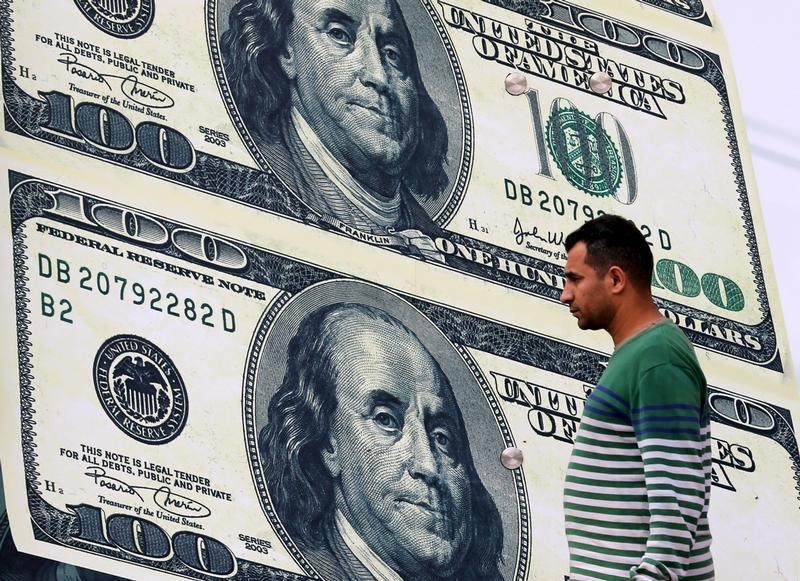Oklo stock tumbles as Financial Times scrutinizes valuation
Investing.com - The U.S. dollar rose Thursday, retaining some strength after the Federal Reserve highlighted stagflation risks at its latest meeting, prompting traders to push out the chance of near-term rate cuts.
At 04:10 ET (08:10 GMT), the Dollar Index, which tracks the greenback against a basket of six other currencies, gained 0.4% to 99.877, having bounced around 0.3% in the previous session.
Dollar gains on hawkish Fed
The U.S. central bank kept its benchmark interest rate steady in the 4.25%-4.50% range on Wednesday, but said that the risks of both higher inflation and unemployment had risen and that the U.S. economic outlook remains uncertain.
Chair Jerome Powell said it isn’t clear if the economy will continue its steady pace of growth, or wilt under mounting uncertainty and a possible spike in inflation.
“The dollar started the day a little stronger after last night’s FOMC meeting, which was read as an acknowledgement of the risk of stagflation (no early Fed cuts),” said analysts at ING, in a note.
Markets scaled back the chance of a June rate cut to just 20%, from 30% a day earlier, while a move in July is now priced at 70%, compared with a near-certainty just a week ago.
The dollar was also helped after U.S. President Donald Trump said he would announce details about a major trade deal with an unspecified country at a press conference later in the day.
The New York Times (NYSE:NYT) reported that the deal was with Britain.
Investors have been buoyed that this, as well as the upcoming trade talks between Washington and Beijing on Saturday, could point to an end of the damaging trade war instigated by Trump at the start of his new presidency.
Sterling fails to gain on trade deal talk
In Europe, EUR/USD traded 0.1% lower to 1.1292, with the single currency slipping back on the dollar strength.
Data released earlier Thursday showed that German exports rose more than expected in March as U.S. demand increased in anticipation of U.S. tariffs and a gain in industrial production also beat expectations.
Exports were up 1.1% in March over the previous month, data from the federal statistics office showed, while imports were down by 1.4%.
Most German exports went to the United States, up 2.4% compared with February, as purchases were brought forward amid looming tariffs.
German industrial production rose in March by 3% compared with the previous month.
GBP/USD edged 0.1% lower to 1.3291, with sterling struggling to benefit from talk of a trade deal between the U.K. and the U.S., as traders await the latest Bank of England rate decision.
A deal between the two countries to lower tariffs on some goods would be the first such agreement since U.S. President Donald Trump imposed levies on countries around the world.
“In focus will primarily be whether the 10% baseline U.S. tariffs in place under the current ’paused’ conditions can be negotiated away,” said ING. “Consensus expects it to remain in place on the view that Washington needs tariff receipts to fund tax cuts this summer. If the baseline 10% is removed, this would be a bullish surprise for risk assets and would probably see an extension of today’s dollar and equity market rally.”
The Bank of England is widely expected to cut rates by 25 bps to 4.25% later in the session, with investors almost fully pricing in three additional rate cuts by the end of the year.
Elsewhere, Sweden’s Riksbank and Norway’s Norges Bank are also scheduled to hold policy-setting meetings, but less is expected from these central banks.
Safe-haven yen slips back
In Asia, USD/JPY traded 0.4% higher to 144.36, with the safe-haven yen retreating on talk of trade deals.
Japanese wage data for March is due on Friday and is widely expected to factor into the Bank of Japan’s plans for interest rates.
USD/CNY traded 0.2% higher to 7.2368, with the Chinese currency taking very limited support from Washington and Beijing confirming that officials will meet for trade talks in Switzerland this week.
Markets see a U.S.-China trade deal as unlikely in the near-term, especially as Beijing reiterated that no major negotiations will take place until the U.S. lowers its steep trade tariffs on the country.
